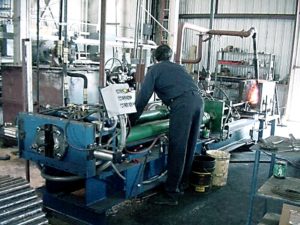
Modern steel production began in the mid-19th century. Prior to 1860, steel was expensive to use. Cast or wrought iron was the preferable material for most applications beyond swords, tools and cutlery. Steel has been vital to the world’s economy since the 1850s, when technological advances made steel much cheaper to produce. Although Britain led the Industrial Revolution and held the market on steel production until about 1875, by 1896, the U.S. outpaced Great Britain in steel production and is now selling more steel to British companies than British producers.
In the U.S., Andrew Carnegie led the iron and steel industry, not because of innovation but rather due to scale. Carnegie Steel had the capability to produce 2,000 tons of pig iron each day. At the turn of the century, Carnegie Steel merged into US Steel. US Steel became the largest and lowest cost producer of steel in the world. The one caveat was the hazards of the steel industry.
From 1910 to 1913, the fatality rate of steel workers was 0.40 per million man hours. The injury rate was 44.1. By 1937, the figures significantly dropped to 0.13 and 11.7 respectively. Still, too many workers were being injured. During World War II, safety worsened, because of labor turnover and the economic boon. When the war ended, accidents went on the decline because trained workers came back into the workforce and the need for steel lessened.
Modern Steel Manufacturers Are Doing Better
Today’s steel manufacturers recognize that the industry is dangerous. Although no type of work can be 100 percent accident-free, there are safety measures that can be taken to prevent many types of injuries. The World Steel Association offers 6 principles for safety and health in the industry:
- All injuries and work-related illness can and must be prevented.
- Management is responsible and accountable for safety and health performance.
- Employee engagement and training is essential.
- Working safely is a condition of employment.
- Excellence in safety and health supports excellent business results.
- Safety and health must be integrated in all business-management processes.
Steel manufacturers and processors must meet strict regulations and requirements from OSHA and other labor organizations, which have greatly reduced the number of incidents in the steel industry. It’s much safer today to do metal fabrication and metalworking.
Steel Is in Demand
Although the steel industry has gone through ups and downs in demand over the last century, at the turn of the millennium, the Chinese and Indian economic boom massively increased the need. Steel is one of the measures of a country’s economic progress. The market took a dip in 2008 when the recession hit, but it is growing again . Worker safety contributes to the availability of steel.
At Metal Forming Solutions, we strive to keep our workers safe when producing a multitude of configurations using Cold Bending and Hot Formed pipe bending. It can be difficult to maintain affordability while maintaining value and quality, but we believe we have found a good balance. Learn more about our metal forming processes; cold form pipe bending and hot form pipe bending for your specific project requirements and allow our 50 years of experience add value to your project. Cold Form Bending. Hot Form Bending.
